Instructional Series
Welcome to the English medium literacy instructional series teaching and learning resources for years 1 to 8.

- 2
- 3
- 4
- English
- Social Sciences
- Science
- Health and Physical Education
- The Arts
- Technology
- Mathematics and Statistics
- Learning Languages
- Fiction
- Non-fiction
- None
- Articles
- Stories
- Poems
- Plays
Search results
138 items - Showing 101 - 110
-
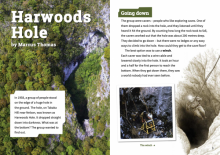
Harwoods Hole
by Marcus Thomas
In 1958, a group of intrepid cavers descended into Harwoods Hole, a huge vertical chasm on Takaka Hill. At the bottom, they discovered a spectacular environment, with beautiful stalactites and waterfalls. A month later, they discovered a second cave nearby. The cavers proved that the two cave systems were connected and created a way to travel between them. The themes of exploration and discovery make this article an enthralling read. It’s also an excellent introduction to the information texts students will be encountering more frequently as they progress through school.
-
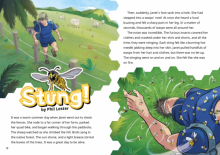
Stung!
by Phil Lester
illustrations by Scott Pearson
When Janet set out to check the fences on her remote sheep farm in Taumaranui, she had no idea that her life would soon be in danger. Based on a real event, “Stung!” recounts what happened when Janet stepped on a wasps’ nest and was attacked by a swarm of angry insects. With no cellphone reception and no one there to help, Janet’s survival depended on incredible stamina and determination. Not surprisingly, the after-effects of the attack have been long lasting.
-
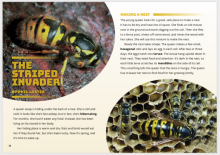
-
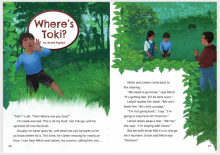
Where's Toki?
by André Ngāpō
illustrations by Phillip Paea
Cousins Hoani, Leilani, and Mitch are searching for their dog, Toki. When they realise he is trapped in a cave, they think about going in to rescue him. However, the potential danger and the possibility that the cave might be tapu stops them. Hoani, the narrator, shows particular sensitivity towards, and respect for, tikanga Māori. The story includes a retelling of a traditional story about Ruakuri Cave at Waitomo (Tainui/Ngāti Maniapoto). “Where’s Toki?” has a happy ending, with Toki escaping the cave from another exit and bounding back to rejoin the delighted children.
-
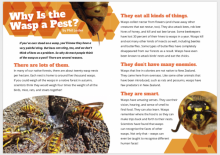
Why is the Wasp a Pest?
by Phil Lester
If you’ve ever stood on a wasp, you’ll know they have a very painful sting. But bees can sting, too, and we don’t think of bees as a problem. So why do most people think of the wasp as a pest?
-

Wētā
by Philippa Werry
Many people are scared of wētā. They are big and covered in spikes, they hide in dark places, and they can sometimes jump. You might find one in the garden or in a piece of old wood. There could be one hiding in your letterbox – or even in your shoe!
-
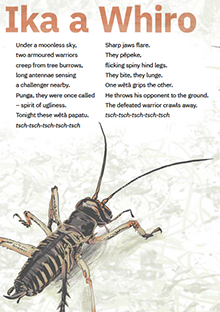
Ika a Whiro
by Kelly Joseph
Under a moonless sky, two armoured warriors creep from tree burrows, long antennae sensing a challenger nearby.
-
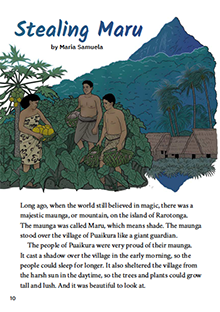
Stealing Maru
by Maria Samuela; illustrations by Elspeth Alix Batt
Long ago, when the world still believed in magic, there was a majestic maunga, or mountain, on the island of Rarotonga. The maunga was called Maru, which means shade. The maunga stood over the village of Puaikura like a giant guardian.
-
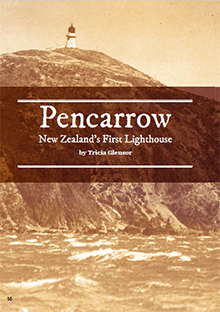
Pencarrow: New Zealand’s First Lighthouse
by Tricia Glensor
New Zealand’s coastline has always been a dangerous place for ships and boats. Early Māori knew that. Several traditional stories tell of waka being washed onto rocks in storms. Since the 1790s, when the first Pākehā reached New Zealand, more than 2,300 ships have been wrecked in New Zealand waters.
-
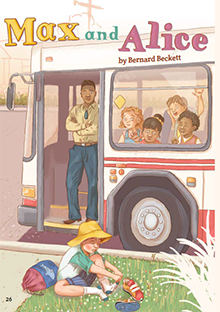
Max and Alice
by Bernard Beckett; illustrations by Sarah Illingworth
On the day of the swimming sports, Max took off his shoes and socks and put them on again three times. Only then was he happy that his socks were lined up exactly the way he liked them.


 Literacy Online home
Literacy Online home
